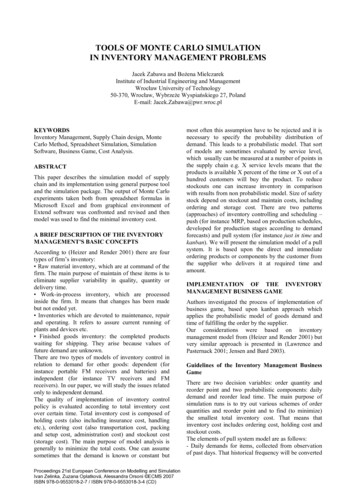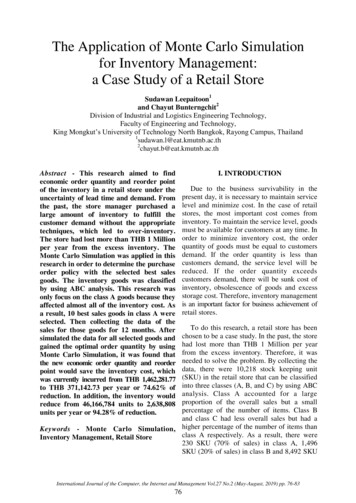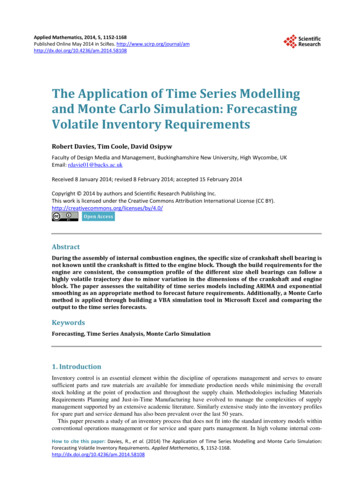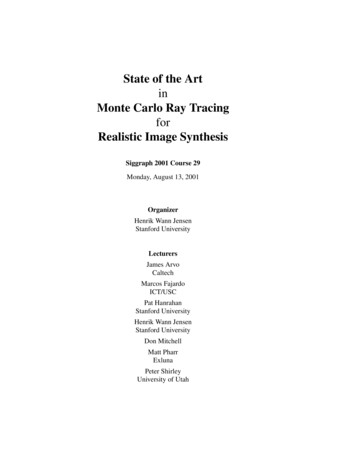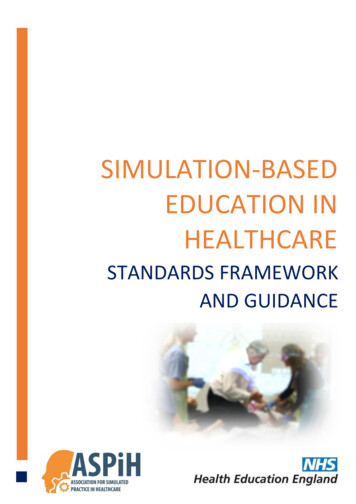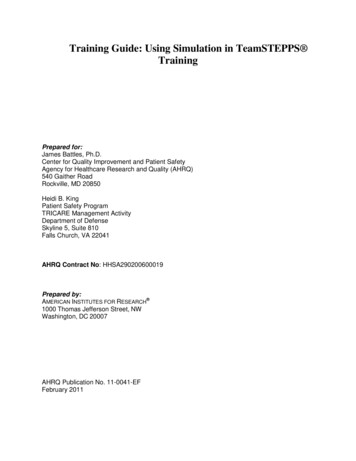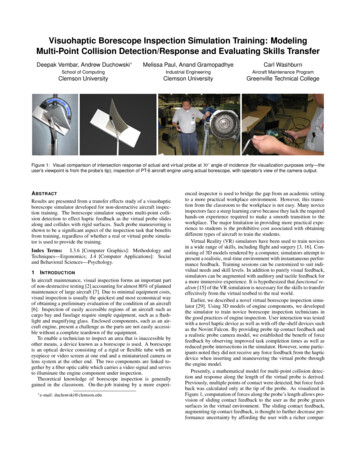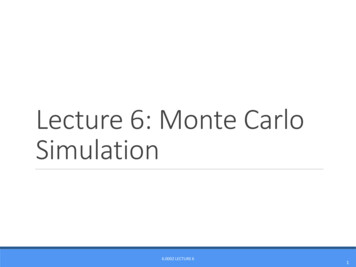
Transcription
Lecture 6: Monte CarloSimulation6.0002 LECTURE 61
Relevant Reading Sections 15-1 ̄ 15.4 Chapter 166.0002 LECTURE 62
A Little History Ulam, recovering from an illness, was playing a lot ofsolitaire Tried to figure out probability of winning, and failed Thought about playing lots of hands and countingnumber of wins, but decided it would take years Asked Von Neumann if he could build a program tosimulate many hands on ENIACImage of ENIAC programmers unknown.This contentis excluded from our Creative Commons license. For moreinformation,see https://ocw.mit.edu/help/faq-fair-use/.6.0002 LECTURE 63
Monte Carlo Simulation A method of estimating the value of an unknownquantity using the principles of inferential statistics Inferential statistics Population: a set of examples Sample: a proper subset of a population Key fact: a random sample tends to exhibit the sameproperties as the population from which it is drawn Exactly what we did with random walks6.0002 LECTURE 64
An Example Given a single coin, estimate fraction of heads youwould get if you flipped the coin an infinite number oftimes Consider one flipHow confident would yoube about answering 1.0?6.0002 LECTURE 65
Flipping a Coin TwiceDo you think that the next flip will come up heads?6.0002 LECTURE 66
Flipping a Coin 100 TimesNow do youthink that thenext flip willcome up heads?6.0002 LECTURE 67
Flipping a Coin 100 TimesDo you thinkthat theprobability ofthe next flipcoming upheads is 52/100?Given the data,ϭ̪ϫ̠ ̜͗̍ͅ bestestimateBut confidenceshould be low6.0002 LECTURE 68
Why the Difference in Confidence? Confidence in our estimate depends upon two things Size of sample (e.g., 100 versus 2) Variance of sample (e.g., all heads versus 52 heads) As the variance grows, we need larger samples to havethe same degree of confidence6.0002 LECTURE 69
RouletteNo need tosimulate, sinceanswers obviousImage of roulette wheel unknown. All rights reserved. This content is excluded from ourCreative Commons license. For more information, see https://ocw.mit.edu/help/faq-fair-use/.6.0002 LECTURE 6Allows us tocomparesimulation resultsto actualprobabilities10
Class Definitionclass FairRoulette():def init (self):self.pockets []for i in range(1,37):self.pockets.append(i)self.ball Noneself.pocketOdds len(self.pockets) - 1def spin(self):self.ball random.choice(self.pockets)def betPocket(self, pocket, amt):if str(pocket) str(self.ball):return amt*self.pocketOddselse: return -amtdef str (self):return 'Fair Roulette'6.0002 LECTURE 611
Monte Carlo Simulationdef playRoulette(game, numSpins, pocket, bet):totPocket 0for i in range(numSpins):game.spin()totPocket game.betPocket(pocket, bet)if toPrint:print(numSpins, 'spins of', game)print('Expected return betting', pocket, ' ',\str(100*totPocket/numSpins) '%\n')return (totPocket/numSpins)game FairRoulette()for numSpins in (100, 1000000):for i in range(3):playRoulette(game, numSpins, 2, 1, True)6.0002 LECTURE 612
100 and 1M Spins of the Wheel100 spins of Fair RouletteExpected return betting 2 -100.0%100 spins of Fair RouletteExpected return betting 2 44.0%100 spins of Fair RouletteExpected return betting 2 -28.0%1000000 spins of Fair RouletteExpected return betting 2 -0.046%1000000 spins of Fair RouletteExpected return betting 2 0.602%1000000 spins of Fair RouletteExpected return betting 2 0.7964%6.0002 LECTURE 613
Law of Large Numbers In repeated independent tests with the same actualprobability p of a particular outcome in each test, thechance that the fraction of times that outcome occursdiffers from p converges to zero as the number of trialsgoes to infinityDoes this imply that ifdeviations from expectedbehavior occur, thesedeviations are likely to beevened out by oppositedeviations in the future?6.0002 LECTURE 614
Gambler’s Fallacy ϮŎ August 18, 1913, at the casino in Monte Carlo,black came up a record twenty-six times in succession̐ϭ̆ ̜̍ͅϿή̪̪ή̑Ϩ ϩ ̐ϴϪή̜ή̑ ͑Β̠ Β ̆ήΒ̜-panicky rush to beton red, beginning about the time black had come up aphenomenal fifteen ̪ϭ̅ή̠Ϩϯ -- Huff and Geis, How toTake a Chance Probability of 26 consecutive reds 1/67,108,865 Probability of 26 consecutive reds when previous 25rolls were red 1/26.0002 LECTURE 615
Regression to the Mean Following an extreme random event, the next randomevent is likely to be less extreme If you spin a fair roulette wheel 10 times and get 100%reds, that is an extreme event (probability 1/1024) It is likely that in the next 10 spins, you will get fewerthan 10 reds But the expected number is only 5 So, if you look at the average of the 20 spins, it will becloser to the expected mean of 50% reds than to the100% of the first 10 spins6.0002 LECTURE 616
Casinos Not in the Business of Being Fair6.0002 LECTURE 617
Two Subclasses of Rouletteclass EuRoulette(FairRoulette):def init (self):FairRoulette. init (self)self.pockets.append('0')def str (self):return 'European Roulette'class AmRoulette(EuRoulette):def init (self):EuRoulette. init (self)self.pockets.append('00')def str (self):return 'American Roulette'6.0002 LECTURE 618
Comparing the GamesSimulate 20Exp. returnExp. returnExp. returntrials of 1000 spins eachfor Fair Roulette 6.56%for European Roulette -2.26%for American Roulette -8.92%Simulate 20Exp. returnExp. returnExp. returntrials of 10000 spins eachfor Fair Roulette -1.234%for European Roulette -4.168%for American Roulette -5.752%Simulate 20Exp. returnExp. returnExp. returntrials of 100000 spins eachfor Fair Roulette 0.8144%for European Roulette -2.6506%for American Roulette -5.113%Simulate 20Exp. returnExp. returnExp. returntrials of 1000000 spins eachfor Fair Roulette -0.0723%for European Roulette -2.7329%for American Roulette -5.212%6.0002 LECTURE 619
Sampling Space of Possible Outcomes Never possible to guarantee perfect accuracy throughsampling Not to say that an estimate is not precisely correct Key question: How many samples do we need to look at before we canhave justified confidence on our answer? Depends upon variability in underlying distribution6.0002 LECTURE 620
Quantifying Variation in Data (X) 1X2(x ) x X Standard deviation simply the square root of thevariance Outliers can have a big effect Standard deviation should always be consideredrelative to mean6.0002 LECTURE 621
For Those Who Prefer Codedef getMeanAndStd(X):mean sum(X)/float(len(X))tot 0.0for x in X:tot (x - mean)**2std (tot/len(X))**0.5return mean, std6.0002 LECTURE 622
Confidence Levels and Intervals Instead of estimating an unknown parameter by a singlevalue (e.g., the mean of a set of trials), a confidence intervalprovides a range that is likely to contain the unknown valueand a confidence that the unknown value lays within thatrange ϮϴϪή ̜ῄ̪̜̆ ̍̆ Οή̪̪ϭ̆Ϡ Β ̙̍Πϼή̪ ϭͼϼ ̪ϭ̅ή̠ ϭ̆ E̜̙̍ͅήΒ̆roulette is -3.3%. The margin of error is /- 3.5% with a 95%level of confidenceϨϯ What does this mean? If I were to conduct an infinite number of trials of 10k betseach, My expected average return would be -3.3% My return would be between roughly -6.8% and 0.2% 95% ofthe time6.0002 LECTURE 623
Empirical Rule Under some assumptions discussed later 68% of data within one standard deviation of mean 95% of data within 1.96 standard deviations of mean 99.7% of data within 3 standard deviations of mean6.0002 LECTURE 624
Applying Empirical RuleresultDict {}games (FairRoulette, EuRoulette, AmRoulette)for G in games:resultDict[G(). str ()] []for numSpins in (100, 1000, 10000):print('\nSimulate betting a pocket for', numTrials,'trials of', numSpins, 'spins each')for G in games:pocketReturns findPocketReturn(G(), 20,numSpins, False)mean, std getMeanAndStd(pocketReturns)resultDict[G(). str ()].append((numSpins,100*mean,100*std))print('Exp. return for', G(), ' ',str(round(100*mean, 3)) '%,', ' /- ' str(round(100*1.96*std, 3)) '% with 95% confidence')6.0002 LECTURE 625
ResultsSimulate betting a pocket for 20 trials of 1000 spins eachExp. return for Fair Roulette 3.68%, /- 27.189% with 95% confidenceExp. return for European Roulette -5.5%, /- 35.042% with 95% confidenceExp. return for American Roulette -4.24%, /- 26.494% with 95% confidenceSimulate betting a pocket for 20 trials of 100000 spins eachExp. return for Fair Roulette 0.125%, /- 3.999% with 95% confidenceExp. return for European Roulette -3.313%, /- 3.515% with 95% confidenceExp. return for American Roulette -5.594%, /- 4.287% with 95% confidenceSimulate betting a pocket for 20 trials of 1000000 spins eachExp. return for Fair Roulette 0.012%, /- 0.846% with 95% confidenceExp. return for European Roulette -2.679%, /- 0.948% with 95% confidenceExp. return for American Roulette -5.176%, /- 1.214% with 95% confidence6.0002 LECTURE 626
Assumptions Underlying Empirical Rule The mean estimation error is zero The distribution of the errors in the estimates isnormal6.0002 LECTURE 627
Defining Distributions Use a probability distribution Captures notion of relative frequency with which arandom variable takes on certain values Discrete random variables drawn from finite set of values Continuous random variables drawn from reals betweentwo numbers (i.e., infinite set of values) For discrete variable, simply list the probability of eachvalue, must add up to 1 C̪̍̆ϭ̠̆̍ͅͅ ΠΒ̠ή ̪̜ϭΠϼϭή̜ϥ ΠΒ̆ϫ̪ ῄ̆̅ή̜Β̪ή ̙̜̍ΟΒΟϭϿϭ̪͗for each of an infinite set of values6.0002 LECTURE 628
PDF’s Distributions defined by probability density functions(PDFs) Probability of a random variable lying between twovalues Defines a curve where the values on the x-axis liebetween minimum and maximum value of the variable Area under curve between two points, is probability ofexample falling within that range6.0002 LECTURE 629
Normal Distributions 1e n 0 n! 68% of data within one standarddeviation of mean 95% of data within 1.96 standarddeviations of mean 99.7% of data within 3 standarddeviations of mean6.0002 LECTURE 630
MIT OpenCourseWarehttps://ocw.mit.edu6.0002 Introduction to Computational Thinking and Data ScienceFall 2016For information about citing these materials or our Terms of Use, visit: https://ocw.mit.edu/terms.
100 and 1M Spins of the Wheel. 100 spins of Fair Roulette Expected return betting 2 -100.0% . 100 spins of Fair Roulette Expected return betting 2 44.0%
